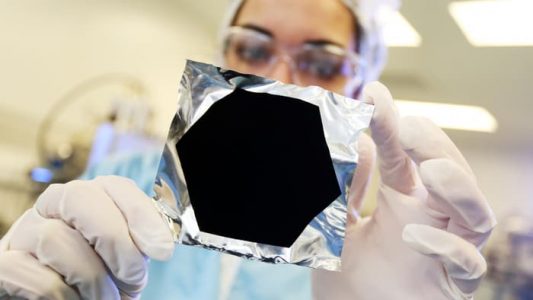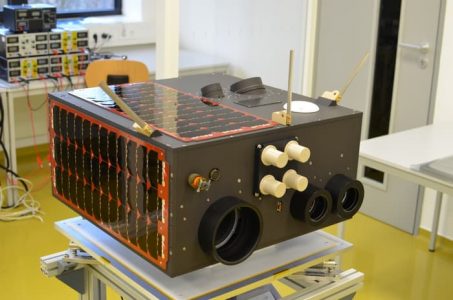
此前小编多次介绍过这种世界上最黑的材料:vantablack,因为黑到家,所以应用的前景非常好,而且很快就用上了。。。
最新消息是这种材料应用在了航天器材中,已经上太空测试了:
NASA在2015年十二月发射Kent Ridge 1号卫星到低地球轨道。这颗78公斤(171磅)微卫星设计目的主要是为了促进整个亚洲的灾害监测和缓解。Kent Ridge 1号卫星通过两个板载的高光谱成像系统和一个高分辨率摄像头,在低地球轨道拍摄遭遇自然灾害的地球图像。
Kent Ridge 1号卫星上将依赖于安装在卫星的顶部和底部的四个星跟踪器,来更准确保持自身位置,如果依靠内部陀螺仪以固定其在空间中的位置,这可能会导致在一段时间内卫星的位置出现漂移。而星跟踪器在跟踪恒星位置的时候,其内部传感器容易受到太阳和月亮光线的干扰,因此需要涂敷光吸收材料来消除干扰。

为此,这颗卫星制造商采用了世界上最黑的材料 – 纳米碳管黑体涂层,它与哈勃太空望远镜使用的光学细腻超黑漆相比,可以减少约17倍的光线反射。这种材料内部的碳纳米管矩阵元素光反射率只有0.2%,跨越很宽的波长范围。此外,这种涂层可以通过喷漆应用在物体表面,使其能应用于工程级的聚合物和复合材料表面。(来源CNBETA)
外文报道(来源surreynanosystems):
Newhaven, UK, May 12, 2016 — The ultra-black Vantablack surface coating material has made its space debut in an optical instrument on board the Kent Ridge 1 satellite. The material’s ability to absorb virtually all incident light improves the performance of the satellite’s star tracker-based positioning control system.
Kent Ridge 1 is a low earth orbit (LEO) microsatellite developed by Berlin Space Technology (BST) in conjunction with the National University of Singapore. It carries two hyper-spectral imaging systems and a high resolution video camera for Earth observation.
The Vantablack coating minimizes interference resulting from stray-light inside the star trackers. The new S-VIS version of Surrey NanoSystems’ Vantablack is used for this application as it is ideally suited to coating complex space-borne components, and its performance far outstrips that of traditionally-used black paints. Vantablack S-VIS is so effective it traps 99.8% of light hitting its surface.
The star tracker is a key element of BST’s microsatellite design. On previous satellite missions, BST has used a super-black paint on the baffles inside the optical positioning system to minimize internal reflections and provide an accurate position reference based on a map of the stars. The availability of Surrey NanoSystems’ Vantablack coatings, which utilize an innovative carbon nanotube structure to absorb light, decreases the amount of reflected light by an order of magnitude compared with conventional coatings, and extends the angular range over which the star tracker is able to operate in the presence of bright light sources such as the Sun and Moon. This improves the robustness of the Earth observation instruments on the satellite, and reduces the need for gyroscope-aided position control that can introduce drift errors over time.
On the Kent Ridge 1 mission, BST decided to apply Vantablack to an existing baffle design, allowing its performance to be compared with previous generation instruments through measurement of the best ‘sun exclusion angle’. However, BST anticipates that it will be able to further reduce the size and weight of its star tracker systems in future, thanks to Vantablack enabling the design of shorter and lighter baffles offering the same high performance.
When BST first heard about Vantablack, the development process of the Kent Ridge 1 satellite was already at a late stage, and there were only a few weeks left before the equipment design was scheduled to be frozen. To meet this challenging timescale, Surrey NanoSystems coated baffles for BST within a time window of around five weeks – a process that included the provision of specifications and many detailed technical discussions. The speed of the production cycle was aided by the use of the S-VIS version of Vantablack, which is applied in a process that is similar to spray painting. The versatility of applying this material made it easy to coat the thin aluminium sections and sharp-edges of the complex 3D baffle shapes.
“A star tracker’s performance relies on achieving high sensitivity,” says Tom Segert, Director of Business Development for Berlin Space Technology. “We believe that Vantablack will reduce the effects of many common sources of error that affect the performance of star tracker systems – allowing the star identification algorithm to function over a considerably wider range than before.”
“The Vantablack coating was originally developed to improve the efficiency of optical systems in space, and this BST satellite project gives us a very early opportunity to prove its performance,” says Ben Jensen, chief technology officer of Surrey NanoSystems. “The material can be used to improve the performance of satellites, but also to dramatically reduce weight and size of optical systems – which could be crucial for future space missions.”
Kent Ridge 1 – which launched in December 2015 – is the latest in a series of successful microsatellites developed by Berlin Space Technology. The company’s philosophy of employing highly simplified satellite designs to enhance reliability, and COTS (commercial off the shelf) technology, has resulted in a unique record of satellite launches and operations.
The super-black Vantablack S-VIS material is so effective that its performance far outstrips that of any other conventionally applied coating, typically achieving a reflectance of less than 0.2%. Unlike other black absorbers, it offers this exceptional performance across a wide-range of viewing angles and wavelengths, which is critical for optical instruments.
The active element of Vantablack S-VIS is a carbon nanotube matrix. The coating is applied using a proprietary process that includes a number of pre- and post-application steps to achieve its ultra-low reflectance. Vantablack S-VIS can be applied to most stable surfaces, making Vantablack S-VIS suitable for many types of engineering-grade polymers and composite materials. The process is scalable and suitable for high-volume production on a range of substrate sizes.
Vantablack has the highest thermal conductivity and lowest mass-volume of any material that can be used in high-emissivity applications. It has virtually undetectable levels of outgassing and particle fallout, thus eliminating a key source of contamination in sensitive imaging systems. It withstands launch shock, staging and long-term vibration, and is suitable for coating internal components, such as apertures, baffles, cold shields and Micro Electro Mechanical Systems or MEMS-type optical sensors.
More information: www.surreynanosystems.com and www.berlin-space-tech.com
ENDS
Pictures are available to download from our images and videos page.
For more information please contact:
Surrey NanoSystems, Euro Business Park, Building 24, Newhaven, BN9 0DQ, UK. T: +44 (0)1273 515899; enquiries@surreynanosystems.com; https://www.surreynanosystems.com
Media contact: Ben Jensen, t: +44 (0) 1273 515899
About Surrey NanoSystems
Surrey NanoSystems combines the best of British ingenuity and materials science for use in the development, growth and commercialization of strategically important nanomaterials, and particularly in the development and commercialization of super-black coatings. The company was founded in 2006 as a spinout from the University of Surrey, and is backed by some of the UK’s most successful IP commercialization and venture capital providers including IP Group PLC, Octopus, NewWave Ventures and Parkwalk Advisors. Located near Brighton in the UK, the company operates a modern cleanroom based nanomaterials research and production facility. www.surreynanosystems.com
About Berlin Space Technologies and Kent Ridge 1
Berlin Space Technologies (BST) is an experienced supplier of small satellite systems and technologies. Together with our partners from the National University of Singapore (NUS) BST has designed, built and launched the small satellite Kent Ridge 1 in December 2015. With for more satellites in the range of 50-80kg under construction BST is one of three German companies that today builds complete satellite systems and the only one who has achieved that without requiring aid of the German (DLR) or European Space Agency (ESA). BST further supplies subsystems to many international space mission and has also already delivered hardware that was successfully installed on the international space station. Berlin Space Technology as a prominent example for profitable and fast growing NewSpace companies and is determined to be a leader for space industry and successful implementation of downstream services.
Berlin Space Technologies GmbH, Max-Planck-Str. 3, D-12489 Berlin, Germany. info@berlin-space-tech.com, +49 30 609812420, www.berlin-space-tech.com
Media contact: Tom Segert